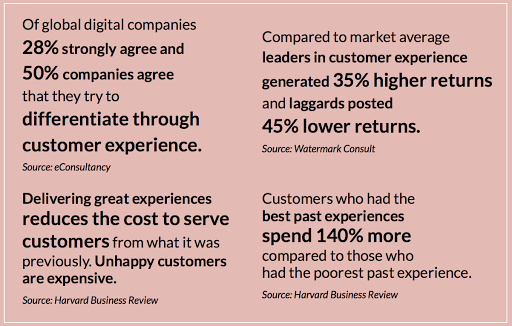The Data Handbook
How to use data to improve your customer journey and get better business outcomes in digital sales. Interviews, use cases, and deep-dives.
Get the bookOur digitalised environment drives the race for customer interface domination. In a digitalised world, product improvement cycles are rapid, and your product may quickly lose its edge and become commoditised competing merely on price.
Numerous companies in different fields are fighting against commoditisation by engaging the customer more strongly with the brand and their services. The primary approach is to build a strong service portfolio around the product and to deliver a superb customer experience.
More importantly, obtaining this kind of strong customer engagement leads to a leading position in the supply chain.
A holistic and uniform customer experience in strategy and operations is what matters
The good news is that it’s easier and cheaper than ever to design digital services and enhanced experiences around your product. However, customers are ever more sensitive to unmet expectations regarding the promised value, service quality and experiences. And delivering what your customer expects from you every single time at every imaginable touchpoint requires an incredibly refined synchronisation and coordination of strategy and operations in real time.
If you are up for the challenge of building superb customer experiences, there is strong evidence that, first and foremost, you need to get the strategy right - otherwise, you will easily end up having a handful of expensive customer touchpoints sending contradicting signals to the customer and failing to serve them systematically (meanwhile your IT becomes a mess).
Aiming for a customer experience that supports your strategy
Every single company cannot - and does not have to - use significant amounts of resources to provide a maximised customer experience in each single customer touchpoint. Rather, you should clearly define what type of value and experiences you are providing to your customers, and analyse if your company is capable of delivering that.
To help define focus areas, we recommend starting with Customer Journey Mapping. You can download our free canvas to identify the touch points that have the most significant business impact.
One-time value proposition first
Is your focus on providing non-customised but premium products or services to all customers? As an example, these could be high-quality hand-made leather shoes, top-notch TV sets, or standardised machine components. In this case, you should identify what are the core experiences and promises that your product or service is providing to the customer and, thereafter, ensure that this promise is kept and outstanding customer experience provided throughout the whole customer lifecycle. However, don’t overperform it, as the most critical part of perceived experience and engagement takes place while using the product or service. Outside that, it is important to communicate the promise and experience and truly engage the customer only in one or two key touchpoints.
Customer intimacy first
Are you planning to always be there for the customer and fill all their more or less obscure needs? As an example, this kind of company could be a banking service for high-income customer segments, an industrial engine service provider, or a premium grocery home delivery provider. In this case, you should identify each single customer touchpoint and align them with your brand and truly invest resources for maximising the perceived customer intimacy and experience at each and every touchpoint. The key is synchronised holistic engagement instead of mere communications.
Efficiency first
Are you mainly competing on volume and price? In this case, you can’t put too much effort into providing exceptional customer experience at every point of the customer’s lifecycle. Still, you should identify a few of the core feelings and values that you want your customer to experience while being engaged with your product and brand and, thereafter, identify how to communicate this throughout the customer’s lifecycle. The key is to identify the critical touchpoints and focus your communication efforts on them and direct significantly less effort on actual engagement - in contradiction to the customer intimacy strategy.

What is your customer truly looking for, and how to provide it?
To be able to define your specific approach to customer experience, it is critical to understand your customer’s job to be done. In short, this refers to the task that your customer is trying to perform by using your product or service. The key is to focus not only on concrete tasks, such as I want to fly to Spain, but rather how the customer wants to do that - the job to be done would then rather be, “I want to get my family to Spain as conveniently as possible with minimum stress”. This approach opens up totally new doors for thinking about your service. More about the job to be done in Harvard Business Review’s excellent article.
After identifying the customer’s job to be done, you can more clearly define what is your value proposition for that particular segment and thereby define what kind of experiences you want the customer to feel and where in the customer’s lifecycle to put your customer experience development efforts.
The Data Handbook
How to use data to improve your customer journey and get better business outcomes in digital sales. Interviews, use cases, and deep-dives.
Get the book




